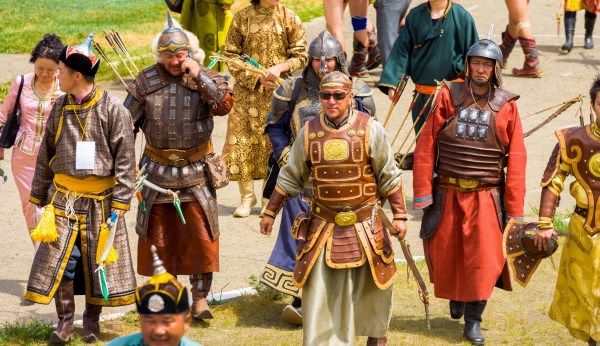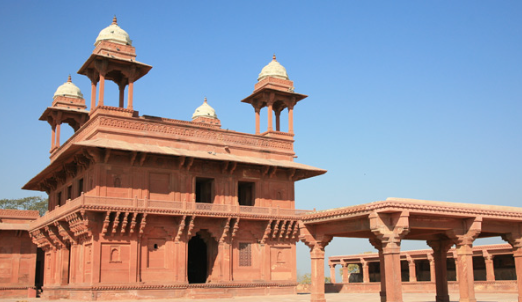[ad_1]
Recognised by UNESCO as Intangible Cultural Heritage, the Naadam Festival unites Mongolians to celebrate their heritage, customs via an enthralling mix of sports and arts. Held every year from July 11-15, it is evidence of their long history, devotion to their nomadic culture, and unwavering national pride. Witness the vigour and spirit of Mongolia, as the whole country comes together in a proud display of majestic festivity.
The Naadam Festival, a three-day celebration of grandiose, held every year from 11th to 13th of July, is the largest and most cherished festival in Mongolia. Referred to as ‘Eriin Gurvan Naadam’, which translates to ‘Three Manly Sports’, it has its roots in the ancient Mongols’ nomadic culture and traditional way of life across the vast steppe. The festival features the three main activities – wrestling, horse racing, and archery, which are closely related to the history and culture of Mongolia.
 Mongolian warrior archers dressed in armour. Picture: Shutterstock
Mongolian warrior archers dressed in armour. Picture: Shutterstock
The festival is an attestation of Mongolia’s legendary military might as the three manly sports were formerly essential training drills for warriors and their horses. Chinggis Khan’s army, known for its efficient organisation, held competitions of these sports to select and confer ranks on to their personnel. Later on, the 19th century saw Mongolia’s People’s Revolution and Naadam developed into a national holiday that signified independence of Mongolia.
Celebrations ahoy
The majestic celebration of the festival not only takes place in the capital city of Ulaanbaatar, but is also held across the country. The festival hosts an addition of ankle bone shooting competition. Horse racing, archery, and ankle-bone shooting sees the participation of women and children, while men can participate in all sports. Along with enthralling performances of long songs and Khöömei overtone singing, mesmerising Bie biyelgee dances, and appeasing tunes of the Morin khuur fiddle, Naadam celebrations go far beyond sporting activities.
 Beautiful Mongolian women dressed in variety of traditional national costumes. Picture: Shutterstock
Beautiful Mongolian women dressed in variety of traditional national costumes. Picture: Shutterstock
The lively atmosphere of the event is brightened up by the proud display and donning of the traditional attire called ‘dell’ and unique gears. Tourists get to experience the rich cultural legacy and authentic customs of Naadam along with the locals, either in Ulaanbaatar or across the country. Everyone gathers, sets up camps in the countryside, and celebrates the festival’s spirit while indulging in regional specialties like Khuushuur, fermented mare milk Airag, and delectable barbecues.
The fierce face off of wrestling
 Mongolian traditional wrestling at the Nadaam festival. Picture: Shutterstock
Mongolian traditional wrestling at the Nadaam festival. Picture: Shutterstock
This distinct style of wrestling, which has a history dating back more than 7000 years, embraces huge open landscapes and nomadic customs. The sport features a variety of rules and is divided into Mongolian bull wrestling, Khalkh wrestling, and Inner Mongolian wrestling. The wrestlers dress in characteristic costumes including shoulder vests, cloaks, traditional boots, and four-sided headgear symbolising their culture. With a gathering of 6000 wrestlers in 2011, Mongolia even broke a Guinness World Record as they celebrated their long legacy of strength and camaraderie.
The elegant art of archery
 Naadam festival’s archery competition. Picture: Shutterstock
Naadam festival’s archery competition. Picture: Shutterstock
Archery, an integral part of the Mongolian culture, grew into a cherished pastime after being first utilised for hunting and then as a potent weapon in wars. Men’s birch wood arrows that are 80–100 cm long and weigh 40–75g are of great significance in this archaic practice. Participants in the Khalh, Buriad, and Uriankhai archery competitions at the Naadam festival dress in traditional attires. These categories are differentiated by differences in bows, arrows, and target ranges, displaying the rich cultural diversity of Mongolia. Uriankhai archery is only for men, whereas Khalh and Buriad welcome men, women, and children. This promotes inclusivity and the preservation of this treasured tradition.
Racing of horses and hearts
 Horseback archers during the Nadaam festival’s opening ceremony. Picture: Shutterstock
Horseback archers during the Nadaam festival’s opening ceremony. Picture: Shutterstock
Mongolia’s horse racing heritage retains a special position in Mongolia’s nomadic culture and unending vistas. The tough and robust Mongolian horses are lovingly regarded as companions besides from being a means of transportation and racing athletes. Horse racing is taught to Mongolians from an early age itself. The Naadam Festival, where horses of all ages compete in spectacular races over a range of distances, is the height of equestrian excitement. Between the ages of 5 and 13, young jockeys expertly control their mounts, cheering them by singing a special song called ‘giingo’. While Mongolians appreciate all horses for their power, resiliency, and steadfast spirit, they don’t just celebrate winners; they hold them in the highest regard. Even the horses which lose are appreciated for their participation.
The sportsmen, sportswomen, and children who participate in the games are revered by both participants and spectators, making the Naadam Festival an embodiment of national pride and harmony. Winners receive titles and are honoured for their accomplishments. The festival encourages participation from everyone, which promotes community involvement and unity. Naadam truly stands as a celebration of the country as a whole.









